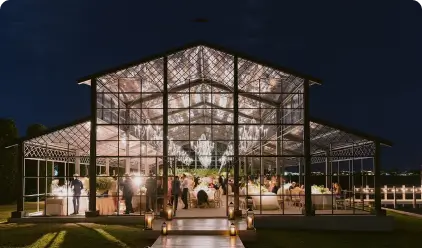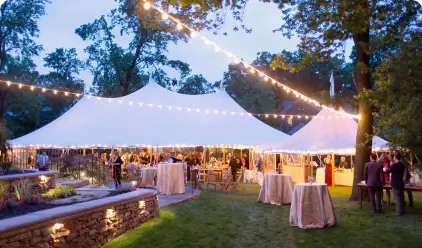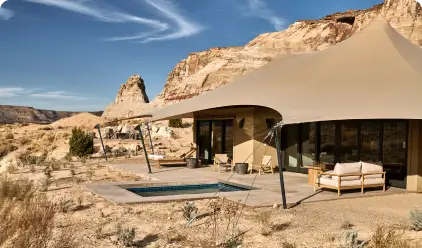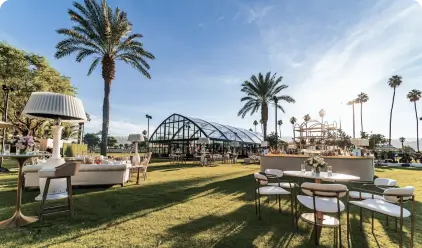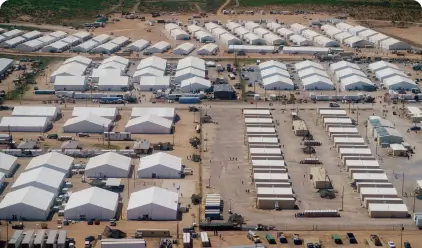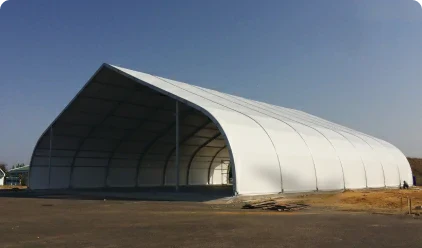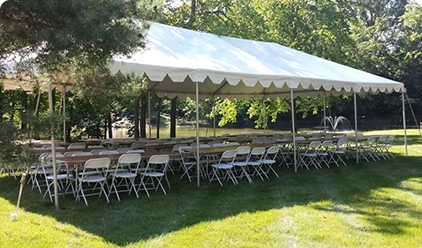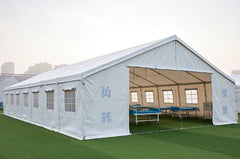10 Steps for Outdoor Event Planning | Checklists
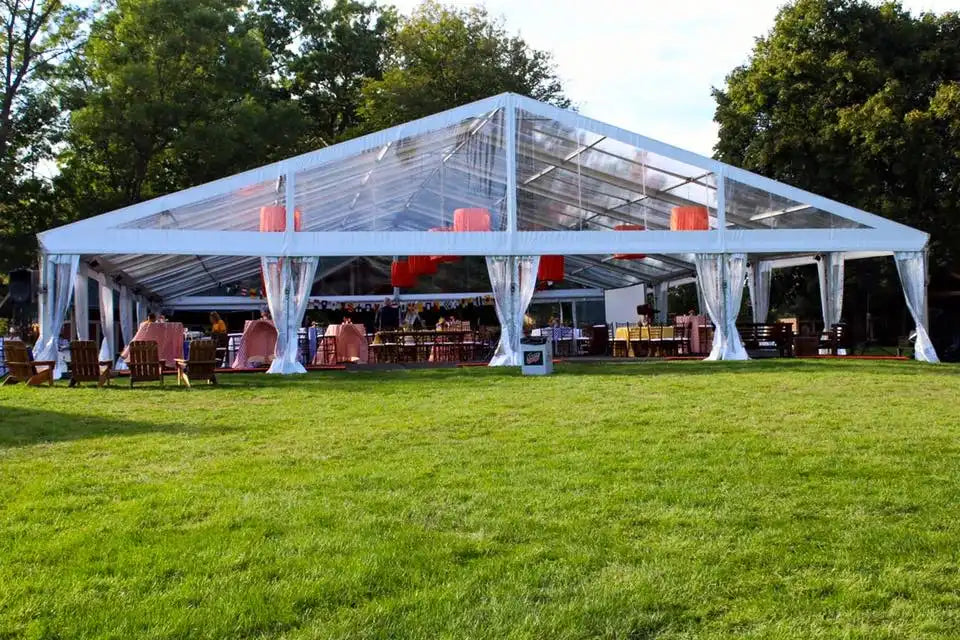
Many people don't know how to plan an outdoor event just because they don't know the right steps or the tips. In fact, it can be pretty easy as long as you do the right things at the right time. Still confused? No worries, here in this blog, we are ready to remind what you should do for your outdoor event planning.
After reading this guide, you'll grasp everything from selecting the perfect venue for your event to planning the theme to partnering with a reliable supplier. It is written for both newcomers and event planners with rich experiences.
So follow the tips below and make out an outdoor event planning checklist to help you organize a more successful outdoor event now!
Checklist for Outdoor Event Planning: You Need to Check
Before preparing for outdoor events, several key factors should be considered. For example, you may need to make a reasonable budget plan for it. Selecting the ideal venue, planning entertainment, buying facilities, cooperating with reliable suppliers, etc., all of these may incur cost and effort.
In the following part, we'll guide you to a detailed checklist of a successful event.
#1 Choose the Right Venue
For any outdoor event, finding a perfect venue is key. Remote areas may offer gorgeous views and could bring guests unforgettable experiences, but they can also make transportation more challenging.
That's why you should find a location where people can get there easily. It must have ample parking for those driving or reliable public transport for others.

In addition, you'll need to consider the space requirements of your venue according to the number of guests, facilities, and accessories. The ideal location should provide enough room to comfortably arrange all your functional areas while still leaving sufficient open space for activities and movement.
Then consider the ground conditions: Whether the event happens on grass, sand, or concrete? Is the ground surface even? Will you need to install temporary flooring or take anti-slip precautions? These details can help you find a perfect venue for your event, so check each of them carefully.
#2 Get the Permits
Hosting events in public or regulated areas requires you to obtain relevant permits. You need to secure venue usage rights first. Then special permits may also be required for activities like nighttime parties, temporary structures (such as stages and tents), and food service operations.
These applications are typically submitted to local government authorities. Before applying, make sure to prepare all required documentation, including your event plan, site layout diagrams, safety personnel details, insurance certificates, and application forms.
Normally, it would take 15-30 working days for the government to process your application. The peak seasons or large-scale events may need more time, so remember to allocate sufficient time for them.
And getting permits isn't a one-and-done affair. You should also maintain ongoing communication with local authorities throughout the event planning and execution phases to ensure compliance with local rules.
#3 Weather Plan for Unpredictable Outdoor Event
The changeable weather can be a big challenge for any outdoor event. When confronted with sudden rain, snow, or wind, a reliable tent can work as a safe shelter for the guests and assets under the tent. For most outdoor activities, the frame tent would be enough.

The framework of this tent is made of engineered aluminum alloy. This material is lightweight, so it is easy to transport and set up. At the same time, it is also durable and sturdy. It still remains stable during its use when facing extremely bad weather conditions. Moreover, it won't be eroded or rusted, even exposed to rain or harsh sunlight for a very long time.
The raw material of its top cover is double-coated PVC, which is 100% waterproof. After being properly installed, it can evenly distribute heavy loads of snow and wind, thus avoiding the sudden collapse of the event tent.
What's more, the fabric is UV-resistant, so it can prevent heat accumulation and harmful ultraviolet rays in hot days.
#4 Consider Accessibility
To create a truly inclusive outdoor event, prioritize accessibility. This means being considerate and ensuring all guests, including people with disabilities, elderly attendees, expectant mothers, and other special needs groups, can participate comfortably.
The key lies in enhancing accessibility throughout the venue. All pathways, including entrances, corridors, and restroom access, should accommodate wheelchair users. The recommended width of walkways should be set at least 90cm.
In addition, try to reduce steps and steep slopes, install temporary ramps, and keep tactile pathways clear of obstacles. So when selecting your venue, choose those even and clean ground surfaces first.
Beyond physical access, consider implementing additional inclusive features:
- Designated accessible parking spaces
- Priority seating areas
- Tailored services like sign language interpreters for hearing-impaired guests
- Braille materials and audio guides for visually impaired attendees
#5 Plan Entertainment and Theme
An attractive outdoor event should have thoughtfully designed entertainment and a distinctive theme. As for entertainment, it should be diverse and engaging. Consider hiring live bands or DJ performances for the main stage, or organizing speech presentations and inviting guests to dance on the floor.
Setting interactive zones like DIY craft stations, game booths, and photo backdrops can also significantly enhance guest participation. For evening events, opt for outdoor movie nights, light shows, or bonfire gatherings. These activities can create magical nighttime experiences.
And don't forget to select a clear event theme (such as family carnivals, retro parties, or outdoor music festivals). This can be decided based on your target audience. Then carry this theme everywhere: in decorations, colors, and all the little details. It helps create a unified look and feel that makes your event special.
#6 Source the Right Equipment

To make the outdoor event more successful, you'll need to prepare essential equipment. Start with the basics, like chairs, tables, and tablecloths, to arrange dining areas for your attendees.
And for the tent lighting, fairy lights, twinkle lights, paper lanterns, and candles are good options. Don't overlook the temperature control - depending on the weather, you may need air conditioners, fans, or even full HVAC systems to cool or heat the party tent.
The right audio equipment can help set the mood. Therefore, try to choose a sound system that properly fits your venue size and ensures even coverage throughout the space. You might also want to include projectors and large screens if you plan to show videos or live streams during the event.
🎈You may also Read: 16 Fun Things to Rent for an Outdoor Party
#7 Manage Outdoor Catering
On occasions like weddings, birthday parties, and music festivals, outdoor dining could add more natural ambience to the event. When managing outdoor catering, there are often more spaces to use.
Then you can arrange more creative setups and provide more immersive experiences for your guests. Usually, this will be achieved in the form of BBQ parties or a buffet, which greatly enhances the interaction between attendees.
You might need to investigate your guests' preferences before it starts. Check if they have any dietary restrictions or allergies. A safe way is to offer universally appealing dishes and desserts like grilled chicken, vegetable skewers, and fresh fruit platters. These foods minimize risks while satisfying diverse tastes.
Once the menu is set, share it with guests and make adjustments promptly. If you want a more budget-friendly plan for outdoor catering, common party foods like tacos, cakes, pies, salads, etc., would also be great.
#8 Comfort Your Guests
Then you also need to ensure the comfort of your guests. For instance, on summer days, keeping the tent cool by dismantling extra sidewalls, doors, or windows is an effective way to create a cozy environment for guests to stay in.
While in freezing days, heat the tent floor, install insulated floor coverings, and provide warm blankets or hand warmers for guests. Always monitor indoor temperatures and be ready to fine-tune your cooling/heating systems to maintain optimal comfort levels.
Beyond climate control, consider other thoughtful amenities, like renting portable restrooms according to the common ratio of about one unit per 50 guests. If your budget allows, set up a charging and lounge area where attendees can relax and recharge their devices.
Always be prepared for emergencies by keeping a well-stocked first aid kit with common medications on hand. All these will make your guests feel cared for throughout the whole event.
H3 #9 Find Reliable Suppliers

No matter if you want to have a tent, decoration, equipment, or dance floor, partnering with reliable suppliers could avoid most issues that you may come across during the outdoor event planning.
Professional vendors always provide products that meet safety standards to reduce the risk of malfunctions or accidents during your event. And thanks to their rich experience, they can quickly troubleshoot issues and offer solutions.
If you want a professional tent, we highly recommend that you choose Sheltent. We have been working in the tent industry for about 10 years. The tents provided by us are all crafted from top-tier quality and expert techniques. They are suitable for any outdoor event like weddings, birthday celebrations, trade fairs, business meetings, etc.
Apart from the qualified tent, we would also give you suggestions to elevate every aspect of your gathering, from tent installation to layout planning to customization services.
#10 Setup and Breakdown
The setup and teardown process significantly impacts both event operations and budget management. For smooth execution, allocate sufficient time for each phase and do it with specific steps.
During setup, you should follow the steps:
- Install power lines and electrical systems
- Construct main structures (stage, tents, etc.)
- Divide functional areas (dining, entertainment, rest zones)
- Add decorative finishes and final touches
For a breakdown, reverse this sequence:
- Carefully remove decorations and equipment
- Dismantle functional areas
- Take down major structures
- Disconnect utilities
At the post-event phase, conduct a thorough cleanup, including:
- Remove all trash and decorations
- Sweep or wash flooring surfaces
- Restore the venue to its original condition
- Verify that no equipment or personal items remain
Bring Your Version to Life - Plan an Outdoor Event with Sheltent
Now you may have understood how to plan your outdoor event, but apparently, bringing these outdoor event ideas into reality just by yourself can be difficult. That's why you need an expert to help you. As a professional outdoor tent supplier, Sheltent have assisted numerous clients in organizing their events in the past few years.
Partnering with us means that you can get:
- Professional-grade equipment meets all safety standards
- End-to-end support from concept to breakdown
- 24/7 expert consultation without extra fees
-
Custom tent solutions tailored to your specific needs
We always take pride in our consistently positive customer feedback. Our clients frequently praise our attention to detail and commitment to excellence. Many have highlighted how our tents provided the perfect blend of functionality and aesthetic appeal.
Whether you're hosting an elegant wedding or a corporate gala, our team will try our best to create unforgettable moments. Let's make your dream event a reality - contact us today for personalized assistance.





























